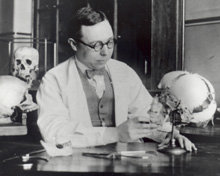Paul H. Stevenson (1890-1971)
Paul H. Stevenson was born in 1890 in Monmouth, Illinois, the son of a Disciples of Christ minister. He graduated from Hiram College in Ohio in 1913, where he himself trained to enter the clergy. Intending to become a medical missionary, he studied at Washington University School of Medicine while serving as pastor of the Maplewood, Missouri Christian Church. He received his MD in 1916 and the following year was a surgical resident at St. Anthony’s Hospital in St. Louis. In 1917 he and his family traveled to China, where he was first at Nanjing and later joined the staff of Luchowfu Christian Hospital in Hefei, Anhui Province. He served there from 1918 to 1920.
Even before leaving St. Louis. Stevenson’s talents as an anatomist brought him to the attention of the China Medical Board of the Rockefeller Foundation, which was then planning to establish an American-style medical research college in Beijing. When the Peking Union Medical College was opened in 1920 Stevenson began his teaching and research career there. During most of the seventeen-year period when Stevenson was a member of the anatomy department, he focused his research in physical anthropology and became a recognized expert on the various ethnic groups of southwestern China and Tibet. He also participated in the analysis of fossilized remains of early hominids at Zhoukoudian (“Peking Man”).
The Japanese invasion of northern China forced the Rockefeller Foundation to transfer Stevenson and others to stateside positions. Stevenson was permitted to retrain for work in public health and entered the doctoral program at Johns Hopkins University. His degree completed in 1941, he accepted a commission with the United State Public Health Service. He was sent to Burma to assist with malaria control during construction the Yunnan-Burma Railway. Japanese advances forced the retreat of allied forces to India, where Stevenson served until 1944.
In the final months of the war, Stevenson returned to the United States and subsequently shifted his career focus once again. He joined the staff of the National Institute of Mental Health in Bethesda, Maryland, where he worked at first to improve the long-term care of patients at psychiatric hospitals. He left the NIMH in 1955 to join the American Korean Foundation and briefly served in Korea directing charitable war recovery efforts. In 1957, he returned to the NIMH and was named director of its Department of Alcoholism until his retirement in 1959.
Stevenson resided in St. Louis during the last decade of his life. He died in 1971.

Related Resources:
- Bodies and Bones: Washington University Medical Alumnus Paul Stevenson at Peking Union Medical College
- Images of Paul H. Stevenson
- Oral History Interview with Helen Wells Stevenson and Lucy Stevenson
Back to Biographies

